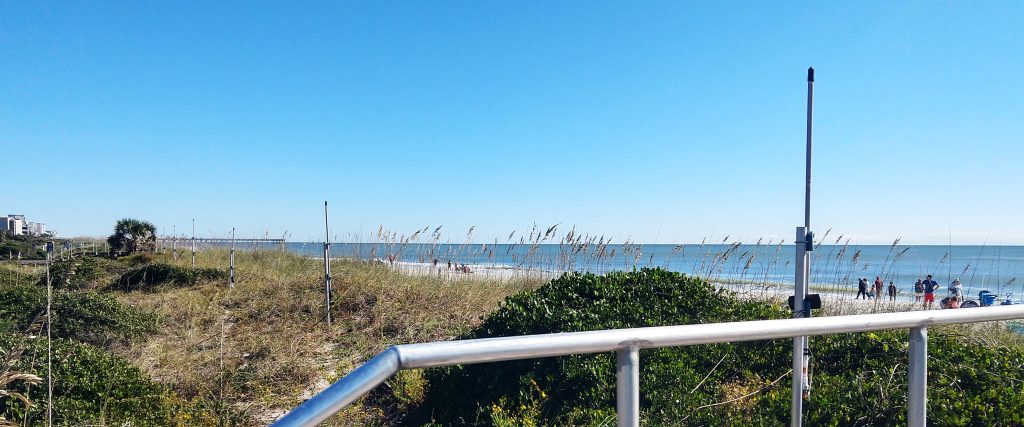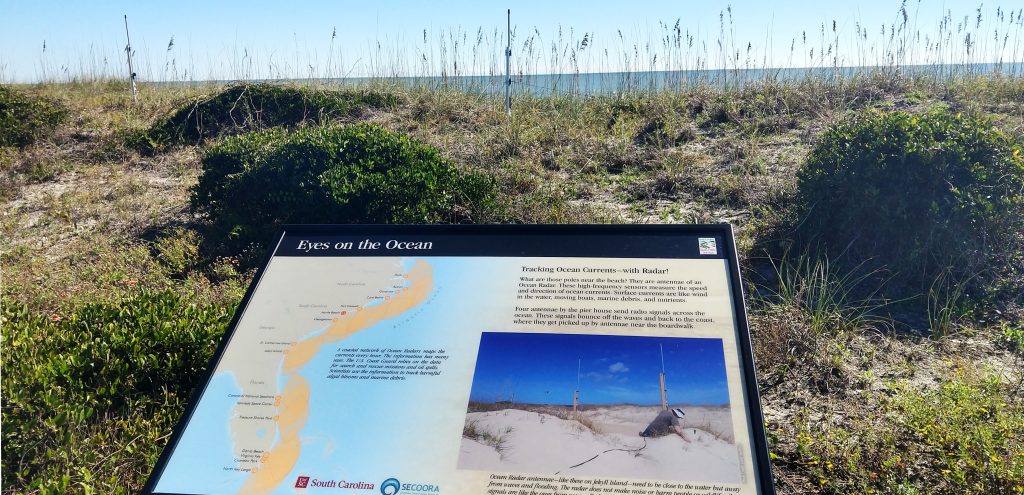A new High Frequency Radar (HF radar) was installed in Myrtle Beach State Park by the University of South Carolina. The new HF radar system was installed to close a gap in HF Radar coverage between Caswell Beach, NC and Georgetown, SC.
Myrtle Beach State Park HF Radar
The radar antennas are located within Myrtle Beach State Park near the pier house. HF radar transmit radio signals across the ocean. These radio signals bounce off of ocean waves and signals are scattered back to the coast where they get picked up by the antennae. The returned signals are analyzed to estimate surface current speed and direction.

Why collect surface current data?
HF radar are land-based systems that measure the speed and direction of ocean surface currents in near real-time. Surface currents can move objects in the ocean such as boats, marine debris, and nutrients.
The data collected by HF radar has many uses, including U.S. Coast Guard search and rescue mission planning and oil-spill response efforts. Scientists use the surface current data to track harmful algal blooms and marine debris and to better understand ocean transport of larval fish, plankton, and nutrients.
Backbone of Coastal Ocean Observing Systems
HF radar networks form the backbone of many coastal ocean observing systems. The broad range of uses is the reason that the National Oceanic and Atmospheric Administration (NOAA) Integrated Ocean Observing System (IOOS®) invests in a national network of HF radar. SECOORA operates a growing network of HF radars in the Southeast. 17 HF Radar are currently deployed from North Carolina to the Gulf coast of Florida and 4 more HFR will be installed on the east coast of Florida by 2022.
The new HF radar was funded by IOOS as a national effort to close the gaps in monitoring the ocean.
Related news

New High Frequency Radar at the Dry Tortugas National Park Improves Ocean Surface Current Measurements Across the Straits of Florida
A new CODAR Low-Power SeaSonde HFR has been deployed by the University of South Florida at Fort Jefferson on Garden Key to measure surface currents to improve understanding and prediction of the Gulf of Mexico Loop Current.

President Biden Proposes Significant Budget Cuts to IOOS for 2025
President Biden’s recent 2025 budget proposal slashed the funding allocated for the Integrated Ocean Observing System (IOOS) by 76%, which would effectively shut down coastal and ocean observing efforts.

Webinar: NOAA Resources to Help Coastal Communities Understand Flood Risk
Join us Wednesday, March 27th at 12 PM Eastern Time for SECOORA's Coastal Observing in Your Community Webinar Series to hear from Doug Marcy with the NOAA Office for Coastal Management.
